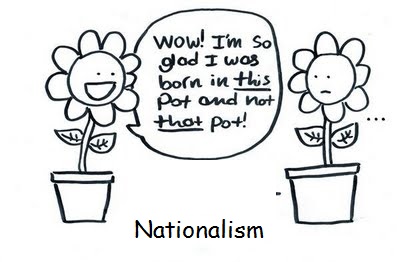What is Nationalism?
Since the late Middle Ages we know that an idea called the “Nation-State” was born. In the 19th century (especially after the French Revolution), national identities solidified even more throughout Europe. What came about was a number of “nationalistic” movements that would re-create European identities. In fact, these feels of nationalism were so strong, that most historians attribute them to the causes of World War I and World War II.
Part 1 of 1: Read and analyze the following paragraphs. These are all examples of nationalism, so look for similarities (critical attributes) that they all share. Then create a definition of nationalism and list 5-6 characteristics of nationalism.
#1
In 1870, Italian troops entered Rome in a final effort to unify Italian-speaking people into one nation, free from foreign rule and controlled by a central government. This effort had begun in the 1830s and continued through the liberal European revolutions of 1848. For the next 20 years leaders such as Count Cavour and Giuseppe Garibaldi negotiated and fought to gain control of territory ruled by Austria, France, and the Catholic Church. By 1866, the Italians had gained control of all territories except for the Papal States, controlled by the Pope and protected by French troops. When war broke out between the Prussians and the French in 1870, the French were forced to withdraw their troops from the Papal States, and the Italians gained control of the final territory and completed the unification of Italy.
#2
In 1898 a rebellion broke out in north-eastern China aimed at expelling foreigners and foreign influence from China. Angered by the steady takeover of the Chinese empire by foreign economic and political interests, the Boxer uprisings resulted in the deaths of hundreds of foreigners and Chinese Christians. Although they were officially denounced by the royal court, secretly they gained support from some people in the Qing court including Empress Dowager Cixi. In 1900, the Boxers took siege on foreigners in the Chinese capital at Beijing. After months of assault, a relief army of German, British, American, French, Japanese, and Russian troops moved in and took control of the city. A peace treaty was signed in 1901 required the Chinese to pay for the failed rebellion.
#3
In 1912 and 1913 the countries of the Balkan Peninsula engaged in two wars. The Balkan countries had previously won independence from the Ottoman Empire during the 19th century when Turkish power in the empire declined. The Slavic people of Serbia, who had gained independence in 1878, wanted to make their country the center of a large Slavic state in alliance with Russia. However, not all Balkan nations were in agreement with Serbia in this matter. In addition, Austria, which had a large Slavic population in the southern part of their empire, did not want Serbia to gain control of the Slavic regions. The two wars resulted in territorial gains for the Balkan countries, but did not completely satisfy them. The tension on the Balkan Peninsula during these wars was a precursor to the tensions that would spark World War I.
Enrichment Set:
Read and analyze the primary sources below. Select quotes from each document (minimum of 6 total) that support your characteristics listed in part 1. Each characteristic must have at least 1 quote.
#1
After the Mexican-American War (1846-1848) and a civil war, a group of conservative Mexicans encouraged Napoleon III of France to intervene in the governing of Mexico. The conservatives were unhappy with the liberal program that President Benito Juarez had been pushing. Encouraged by the French, Maximilian von Hapsburg of Austria took over the throne of Mexico in 1864. However, Maximilian did not live up to the conservatives hopes; he supported some of Juarez’ s liberal policies that had been installed before his reign. Despite this support, the former president of Mexico Benito Juarez rejected the idea of a foreign emperor and organized a resistance movement. When Napoleon III withdrew French troops in 1867, Maximilian was captured and executed.
#2
By the 1900s the feminist movement was encouraging legal and economic gains for women in various parts of the world. Women campaigned to have the right to vote and the right to higher education, as well as equal access to divorce and child custody. Although the movement was peaceful in some countries, in Great Britain Emmeline Pankhurst led a more militant suffrage movement which included several attention-getting disturbances, such as planting bombs, smashing windows, and arson. Pankhurst and many other suffragettes went on to prison in the first part of the 20th century. Women received the right to vote on the same basis as men in Great Britain in 1928.
#3
Between 1807 and 1812 leader Napoleon of France took control of German-speaking lands and re-organized many German states under French rule. In response, many Germans fought to free their lands from French rule, and moreover, demand a single, unified German state. Germany remained politically fragmented for years until Prussian chancellor, or prime minister, Otto von Bismarck used his strategy of Realpolitik to create the modem German nation. This strategy – using practical politics over moral principles – led Bismarck to wage wars against Denmark, Austria, and France in order to “liberate” German lands under foreign rule. Within a decade, Bismarck had completed the unification of Germany under Prussian rule through “blood and iron.”
